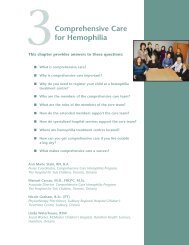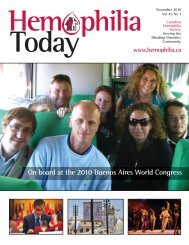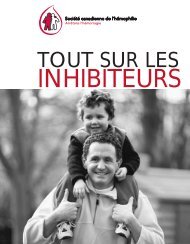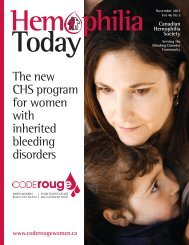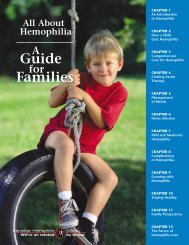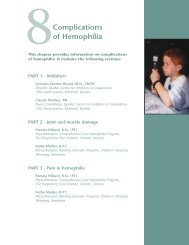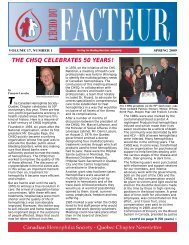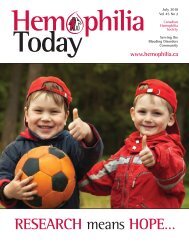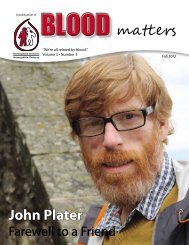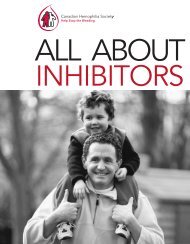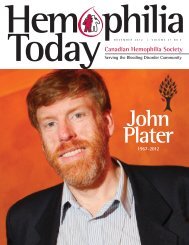Download
Download
Download
- No tags were found...
Create successful ePaper yourself
Turn your PDF publications into a flip-book with our unique Google optimized e-Paper software.
24female factorHEMOPHILIA TODAY SUMMER 2002members of the committee were concernedthat there is a plan to remind donors of theirplanned donations through a central callcentre rather than through local volunteers, asin the past. There was a concern that this coulddetrimentally affect donations. CBS presenteda study which showed that individuals werevery happy with the quality of service theyreceived from the call centre. The CBS isgradually introducing this project and Torontoand Vancouver will be the first localities to beplugged into the Sudbury call centre.Some of you may remember an earlierarticle in Hemophilia Today on the CanadianBlood Services Selection Advisory Committee(SAC), which was a committee set up to advisethe CBS on its future contracts withfractionators and blood product suppliers (Vol.37, No. 1, Spring 2002). There was a briefupdate on this process at the NLC. From thestandpoint of the hemophilia community, verylittle will change. Individuals will still have thesame choice of product, with the additionalchoice of Wyeth’s recombinant product,Refacto® (see page 4), which recently receivedits license. The details of the contracts are stillin the process of being negotiated but they willlikely be for three years.Finally, the issue of the Patient NotificationSystem was raised, and CBS stated that itwould continue advocating with the Americanwebsite company to implement a Frenchlanguage version of the site. The translationhas all been done, and it is merely a matter ofcoding it on the website. Hopefully, this willhappen by the end of August.A draft policy on blood, bloodproducts and their alternatives wasdeveloped for the CanadianHemophilia Society (CHS) by itsBlood Safety Committee andapproved on June 18, 2002. It will besubmitted to the CHS Board ofDirectors for adoption in November,2002. In the meantime, theCommittee members welcomecomments or suggestions frommembers of the CHS, from healthprofessionals who treat people withbleeding disorders and from thegeneral public. The draft policy canbe found on the CHS web site atwww.hemophilia.ca/en/15.htmlFEMALEFACTORTHEVon Willebrand Factor Levelsand Exercise:Is it Worth the Sweat?Patricia StewartStudies show that physical exercise affectshemostasis. The question arises, “Whateffect does this have on menstrual bloodloss in women with Type 1 von Willebranddisease (VWD)?” Dr. Rochelle Winikoff, aHematology Clinical Research Fellow at Ste-Justine Children’s Hospital inMontreal, conducted a study toexamine whether or not, and to whatextent, intense aerobic exercisesession would affect the level of vonWillebrand factor (vWF), factor VIII(FVIII) and closure times (in vitrobleeding time) in a group of fortyhealthy, premenopausal women. Dr.Rochelle Winikoff is Co-Investigatorand Project Director, and Dr.Georges-Etienne Rivard is thePrincipal Investigator. Dr. Winikoffpresented the results of this study atthe World Federation of HemophiliaCongress in Seville in May 2002.In the first phase of this study,forty healthy women aged 18 to 40without any history of bleedingparticipated. These women tookpart, individually, in vigorous exercisesessions at the hospital. A stepping exercisewas done to bring about maximal heart rateand sweat, and was the equivalent of a slowto moderate jog. A filter paper patch placedon the forearm was used to collect the saltproduced in the sweat during the vigorousexercise. The sodium content from the patchwas measured before and after exercise. Onaverage, women had fifty times the baselinemeasurement increase in the sodium content.Factor levels were measured before exercising,immediately after exercising and then again30 minutes later.Results demonstrate a mean 37% increasein vWAg and a mean 58% increase in FVIII:Clevels over baseline when adjusted forbaseline values. These changes remainedsignificant 30 minutes after the exercise. Thehalf-life of vWF is known to be 6 to 12 hoursafter exercise depending on the duration andintensity of the exercise. Sixty-five per centand 92% of participants achieved at least a20% increase in vWAg and FVIII:C levelsover baseline values, respectively, afterThis section is related specifically towomen with bleeding disorders and theirfamilies. All articles are reviewed byphysicians to ensure medical accuracy.If you have any questions, comments orideas, feel free to contact me, PatriciaStewart, at the following addresses:Phone & Fax: 418-884-2208 or e-mail:stewart.page@globetrotter.ca or simply put pento paper and mail to: 389, R.R. # 4, La Durantaye,Quebec G0R 1W0exercise. It is unclear whether or not mild ormoderate exercise would produce a similareffect. There is no known significant increasein other coagulation factors after intenseexercise.Dr. Winikoff is now in the second phase ofthis study. This time, the subjects arepremenopausal women between the ages of18 and 40; all have Type I VWD andmenorrhagia. This is a crossoverstudy whereby each subject willalternate between exercise andrest cycles for four consecutivemenstrual periods. Subjects inthis phase of the study will dovigorous exercise at home. Foreach menstrual cycle, subjects willnote their blood loss using apictogram. From this, a semiquantitativemenstrual score willbe calculated for each subject andcompared between cycles. Dr.Winikoff will not know whichcycle the woman is in, exercise orrest, when she gets the results.Once again, in order to assurecompliance with vigourousexercise, the sweat chloridecontent of the patch will be used.At the present time, thirteen of forty subjectsare registered in the study. Due to the limitednumber of eligible women, no end time hasbeen given for the results.When asked why exercise increases vWFlevels, Dr. Winikoff gave the followingexplanation: “It’s known that vWF and FVIIIincrease in soldiers and marathon runnersfollowing strenuous physical activity or stress.It’s possible that there is a relation toincreased adrenaline which releases thesefactors. However, there is also an increase infibrinolysis which promotes bleeding, untilmaximum heart rate is achieved, after whichvWF & FVIII increases take precedence.”In the hope of avoiding some of theunpleasant and potentially serious side effectsof desmopressin (a drug commonlyprescribed to reduce bleeding in VWD),which include headaches, flushing and, inrare cases, heart attacks, this naturalintervention holds promise in improving thebleeding profile of women affected with Type1 von Willebrand disease.



